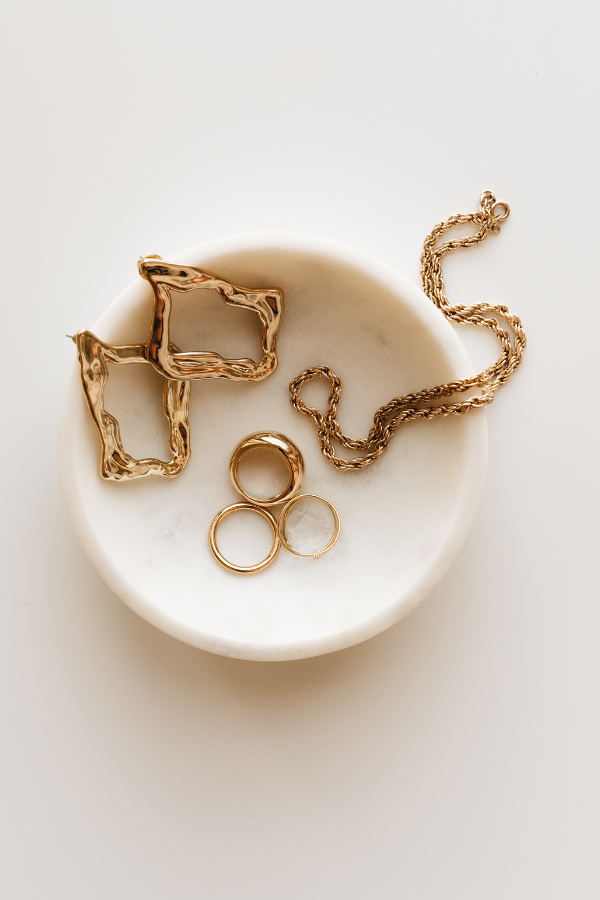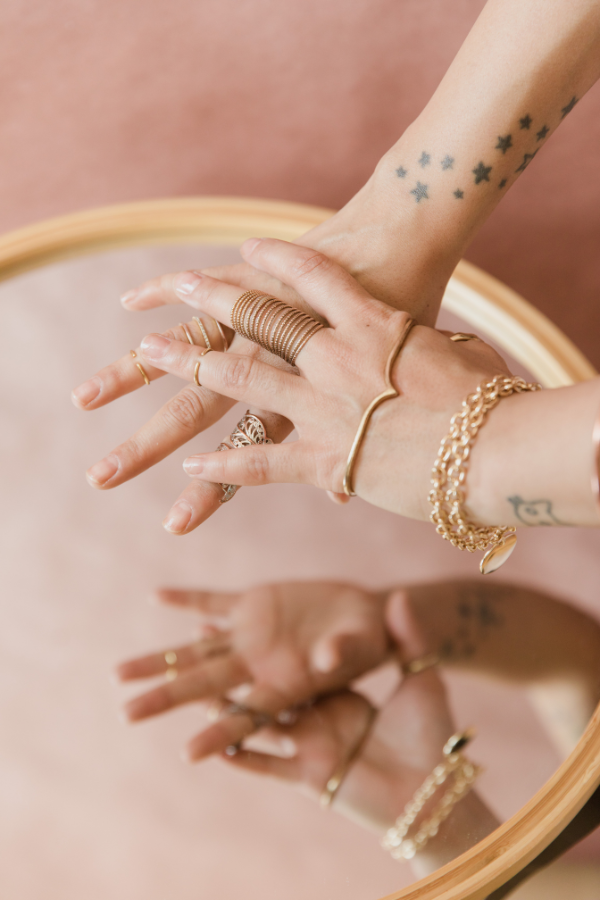
How to Clean Solid Gold and Gold-Plated Jewelry at Home
Summary
Reflection Questions
Journal Prompt
Wondering how to clean gold jewelry at home without damaging the finish? Our step-by-step guide will show you how to identify and clean gold jewelry with gentle methods that won’t scratch the soft metal or loosen stones. However, if you’re unsure about the stability or specific materials, we recommend consulting a professional jeweler or making a trip to the jewelry store from which you purchased the piece instead of cleaning it yourself.
The DesignDash Guide to Cleaning Gold Jewelry Safely at Home

Before you begin, you should determine whether your jewelry is solid gold, gold vermeil, or gold-plated. Solid gold pieces are more durable and can withstand gentle brushing with a soft-bristle toothbrush, while vermeil and plated jewelry require a much more delicate touch.
To figure this out, look for markings on the jewelry. Solid gold is usually stamped with its karat weight (e.g., 14K or 18K), vermeil will often be marked with “925” or “sterling,” and gold-plated items will either have no stamps or be marked with “GP” or “GEP.”
Now, you’re ready to learn how to clean gold jewelry at home!
Materials and Tools Needed to Clean Gold Jewelry

- Mild clear dish soap
- Warm water
- Soft toothbrush
- Soft microfiber cloth
- Small bowl
How to Clean Gold Jewelry Step-by-Step
- Prepare the Cleaning Solution: Mix a few drops of mild dish soap with warm water in a small bowl. Avoid body washes with dyes or fragrances.
- Soak the Jewelry: Lower your gold jewelry into the soapy water and let it soak for about 15-20 minutes. This helps loosen any dirt or grime.
- Brush Gently: Use a soft-bristled toothbrush to gently scrub your gold jewelry. You can use an old toothbrush as long as it is clean. Pay special attention to crevices and intricate designs where dirt can accumulate as you clean your jewelry.
- Rinse: Rinse the jewelry thoroughly under warm running water to remove any soap residue.
- Dry and Polish: Pat the jewelry dry with a soft rag or microfiber cloth. Avoid using a paper towel as it might scratch the gold. For extra shine, you can gently buff the jewelry with the cloth.
Can I Clean My Silver Jewelry the Same Way?

The short answer is “no,” although there is some overlap in cleaning methods.Interestingly, gold jewelry can actually be soaked longer in a gentle solution—between fifteen and twenty minutes compared to between ten and fifteen minutes for sterling silver. While you can use a mild soap and water solution to clean both silver and gold jewelry, silver is a bit more work.
When you clean silver jewelry, you’ll probably need a different jewelry cleaning solution. Gold is a soft metal that can be damaged by abrasive materials, but silver can withstand more aggressive cleaning. For example, you might use baking soda and aluminum foil for deep cleaning tarnish or a non-abrasive silver polish. While both types of jewelry benefit from a gentle polish, silver usually needs more frequent polishing because it tarnishes. Luckily, gold doesn’t suffer from that issue.
What About Gold-Plated and Gold Vermeil Jewelry?

You can’t clean your gold vermeil and gold-plated jewelry the same way you clean your pure gold rings, earrings, or necklaces. Gold vermeil is sterling silver coated with a thick layer of gold, while gold plating typically has a base metal with a thin layer of gold. Because of this layered construction, aggressive cleaning methods can wear away the gold layer and expose that underlying metal.
To clean gold vermeil or gold-plated jewelry, apply a gentle touch and avoid harsh chemicals. Mix a few drops of mild dish soap with warm water and soak the jewelry for only a few minutes. Use a soft cloth to gently wipe away dirt and avoid using brushes or abrasive materials that can scratch or wear away the gold layer. Rinse the jewelry with warm water and pat it dry with a soft, non-abrasive cloth.
To maintain its shimmer, store gold vermeil and gold-plated jewelry in a soft pouch or separate compartment to prevent scratching. Minimize exposure to air and moisture, as both can accelerate tarnishing and wear of non-solid gold pieces.
When NOT to Clean Your Gold Jewelry at Home
Delicate or Antique Pieces
Antique or very delicate jewelry might have fragile settings or materials that can be damaged by even mild cleaning methods. These pieces often require specialized care that only a professional jeweler can provide.
Fuel your creative fire & be a part of a supportive community that values how you love to live.
subscribe to our newsletter
*please check your Spam folder for the latest DesignDash Magazine issue immediately after subscription

Heavily Tarnished or Stained Jewelry
Heavy tarnish, stubborn dirt, or obvious stains may require stronger chemicals that can damage the jewelry if not used correctly. Incorrect use of these chemicals can cause irreversible damage to the metal or stones.
Jewelry with Soft or Porous Gemstones

Gemstones like pearls, opals, turquoise, and emeralds are soft and porous, meaning they can be easily scratched or damaged by water and chemicals. Invest in a professional cleaning if your jewelry boasts any of these delicate stones.
Jewelry with Loose Stones or Damaged Settings

Cleaning jewelry with precious gemstones that have come loose or damaged settings can exacerbate the issue, causing loose stones to fall out. Don’t risk damaging your diamond jewelry! It’s better to have the stone settings repaired by a jeweler before attempting any cleaning.
Complex or Intricate Designs
Intricate designs can have small crevices that are difficult to clean thoroughly at home. Jewelers have specialized tools to clean these intricate details without causing damage.
Jewelry with Special Finishes or Treatments
Jewelry with special finishes (e.g., patinas, coatings) or treatments (e.g., dyeing, oiling) can be damaged by at-home cleaning methods. A jeweler will know how to clean these pieces without damaging the finishes or treatments.
Uncertainty About Materials or Methods
If you’re unsure about the materials used in your jewelry, it’s safer to seek help from professional jewelers instead of trying to clean jewelry yourself. For example, costume jewelry might look like it’s gold or gold-plated. Misidentifying a material or using the wrong cleaning method can cause damage that a professional could avoid.
Final Thoughts
Cleaning your gold jewelry at home can be simple and effective as long as you use the right methods and materials. However, knowing when to seek professional help is incredibly important for maintaining your jewelry’s beauty and structural integrity. Delicate pieces with loose stones, unusual materials, and/or complex designs usually require a jeweler’s expert handling. Again, if you’re uncertain about your jewelry’s materials or the appropriate cleaning methods, consult with a professional. If you’re a jewelry designer, please share your tips and tricks for jewelry care in the comments below.
Do you have silver jewelry to clean at home? Consult this DesignDash Guide.








